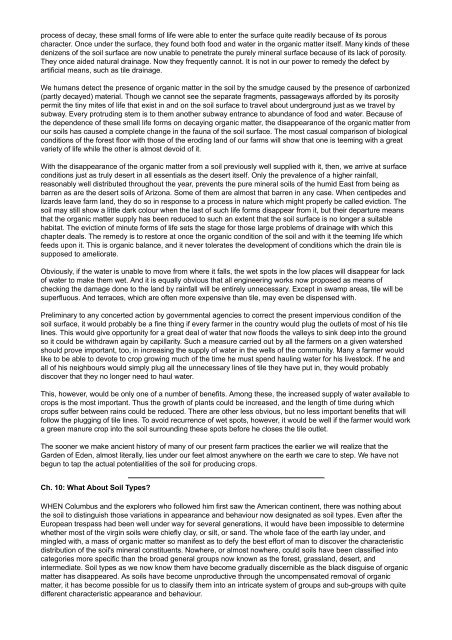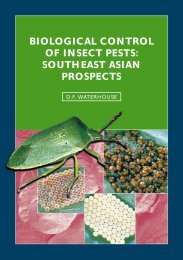Ploughman's Folly Ploughman's Folly - EcoPort
Ploughman's Folly Ploughman's Folly - EcoPort
Ploughman's Folly Ploughman's Folly - EcoPort
You also want an ePaper? Increase the reach of your titles
YUMPU automatically turns print PDFs into web optimized ePapers that Google loves.
process of decay, these small forms of life were able to enter the surface quite readily because of its porous<br />
character. Once under the surface, they found both food and water in the organic matter itself. Many kinds of these<br />
denizens of the soil surface are now unable to penetrate the purely mineral surface because of its lack of porosity.<br />
They once aided natural drainage. Now they frequently cannot. It is not in our power to remedy the defect by<br />
artificial means, such as tile drainage.<br />
We humans detect the presence of organic matter in the soil by the smudge caused by the presence of carbonized<br />
(partly decayed) material. Though we cannot see the separate fragments, passageways afforded by its porosity<br />
permit the tiny mites of life that exist in and on the soil surface to travel about underground just as we travel by<br />
subway. Every protruding stem is to them another subway entrance to abundance of food and water. Because of<br />
the dependence of these small life forms on decaying organic matter, the disappearance of the organic matter from<br />
our soils has caused a complete change in the fauna of the soil surface. The most casual comparison of biological<br />
conditions of the forest floor with those of the eroding land of our farms will show that one is teeming with a great<br />
variety of life while the other is almost devoid of it.<br />
With the disappearance of the organic matter from a soil previously well supplied with it, then, we arrive at surface<br />
conditions just as truly desert in all essentials as the desert itself. Only the prevalence of a higher rainfall,<br />
reasonably well distributed throughout the year, prevents the pure mineral soils of the humid East from being as<br />
barren as are the desert soils of Arizona. Some of them are almost that barren in any case. When centipedes and<br />
lizards leave farm land, they do so in response to a process in nature which might properly be called eviction. The<br />
soil may still show a little dark colour when the last of such life forms disappear from it, but their departure means<br />
that the organic matter supply has been reduced to such an extent that the soil surface is no longer a suitable<br />
habitat. The eviction of minute forms of life sets the stage for those large problems of drainage with which this<br />
chapter deals. The remedy is to restore at once the organic condition of the soil and with it the teeming life which<br />
feeds upon it. This is organic balance, and it never tolerates the development of conditions which the drain tile is<br />
supposed to ameliorate.<br />
Obviously, if the water is unable to move from where it falls, the wet spots in the low places will disappear for lack<br />
of water to make them wet. And it is equally obvious that all engineering works now proposed as means of<br />
checking the damage done to the land by rainfall will be entirely unnecessary. Except in swamp areas, tile will be<br />
superfluous. And terraces, which are often more expensive than tile, may even be dispensed with.<br />
Preliminary to any concerted action by governmental agencies to correct the present impervious condition of the<br />
soil surface, it would probably be a fine thing if every farmer in the country would plug the outlets of most of his tile<br />
lines. This would give opportunity for a great deal of water that now floods the valleys to sink deep into the ground<br />
so it could be withdrawn again by capillarity. Such a measure carried out by all the farmers on a given watershed<br />
should prove important, too, in increasing the supply of water in the wells of the community. Many a farmer would<br />
like to be able to devote to crop growing much of the time he must spend hauling water for his livestock. If he and<br />
all of his neighbours would simply plug all the unnecessary lines of tile they have put in, they would probably<br />
discover that they no longer need to haul water.<br />
This, however, would be only one of a number of benefits. Among these, the increased supply of water available to<br />
crops is the most important. Thus the growth of plants could be increased, and the length of time during which<br />
crops suffer between rains could be reduced. There are other less obvious, but no less important benefits that will<br />
follow the plugging of tile lines. To avoid recurrence of wet spots, however, it would be well if the farmer would work<br />
a green manure crop into the soil surrounding these spots before he closes the tile outlet.<br />
The sooner we make ancient history of many of our present farm practices the earlier we will realize that the<br />
Garden of Eden, almost literally, lies under our feet almost anywhere on the earth we care to step. We have not<br />
begun to tap the actual potentialities of the soil for producing crops.<br />
Ch. 10: What About Soil Types?<br />
WHEN Columbus and the explorers who followed him first saw the American continent, there was nothing about<br />
the soil to distinguish those variations in appearance and behaviour now designated as soil types. Even after the<br />
European trespass had been well under way for several generations, it would have been impossible to determine<br />
whether most of the virgin soils were chiefly clay, or silt, or sand. The whole face of the earth lay under, and<br />
mingled with, a mass of organic matter so manifest as to defy the best effort of man to discover the characteristic<br />
distribution of the soil's mineral constituents. Nowhere, or almost nowhere, could soils have been classified into<br />
categories more specific than the broad general groups now known as the forest, grassland, desert, and<br />
intermediate. Soil types as we now know them have become gradually discernible as the black disguise of organic<br />
matter has disappeared. As soils have become unproductive through the uncompensated removal of organic<br />
matter, it has become possible for us to classify them into an intricate system of groups and sub-groups with quite<br />
different characteristic appearance and behaviour.






